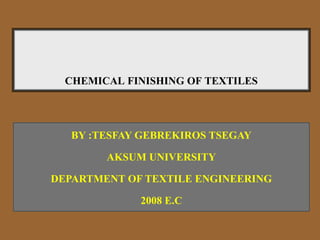
chemical finishing of textiles
- 1. CHEMICAL FINISHING OF TEXTILES BY :TESFAY GEBREKIROS TSEGAY AKSUM UNIVERSITY DEPARTMENT OF TEXTILE ENGINEERING 2008 E.C
- 2. 22 INTRODUCTION Chemical Finishing refers to the use of chemicals to achieve a desired end-use property. Processes that change the chemical composition of the fibers OR improve the surface characteristics Can be applied in yarn, fabric, and garment stages Can be durable or on durable based on resistance to laundering Chemical finish is solution or emulsion of active chemical in water Wet Finishing
- 3. METHOD OF APPLICATION EXHAUST APPLICATION PAD-DRY-CURE --- Most widely used Chemicals that have strong affinities for fiber surfaces can be applied in batch/discontinuous processes by exhaustion Chemicals that have low/no affinity for fibers are applied by continuous processes that involve padding with chemical solution, squeezing, drying and curing for fixation
- 4. 4 By passing fabric through chemical finish solution by ‘wet on dry’ process. Factors affecting wet pick up: Fiber, yarn and fabric characteristics Machine settings [e.g. Squeeze pressure] Solution properties [Viscosity, surface tension] PAD APPLICATION OF CHEMICALS
- 5. 5 PAD-DRY-CURE HIGH WET PICKUPS [70–100 %] IN PADDING TECHNIQUES
- 6. 6 Removal of large amount of water during drying Migration leading to uneven finish distribution For consistent chemical application: Nip pressure should be uniform across the fabric width Solution level & temperature in pad should be constant Fabric speed should not vary throughout the application
- 7. Wet pickup’ (wpu): amount of finishing solution applied Add on: amount of supplied chemical added to the fabric gpl to weight percent concentration IMPORTANT CONCENTRATION RELATIONS
- 8. Feed rate to maintain constant liquor level in the pad A cotton fabric is to be treated with 5.0 % on weight of fabric (owf) with a chemical finish in a wet on dry padding process. If the wet pickup is 90 %, what concentration of chemical is needed?
- 9. If the solution density is 1.05 g ml–1 ,what is the required concentration in g l–1? If the fabric with linear density of 0.250 kg m–1 has a speed of 80 m min–1, what is the flow rate of solution necessary to maintain a constant level in the pad?
- 10. The same fabric is to be treated with 5 % owf of same chemical finish in wet on wet pad application with entry wet pickup of 75 %, exit wet pickup of 90 % and interchange factor of 0.7. What is the effective wet pickup? WET ON WET APPLICATION wpu0 is percentage wet pickup of fabric exiting the pad wpui is percentage wet pickup of fabric entering the pad f is the interchange factor, a measure of interaction between incoming water and the pad solution (0-1)
- 11. ECONOMICALAND ENVIRONMENTAL IMPACT REDUCTION OF APPLIED WATER LOW WET PICKUP METHODS PAD APPLICATION?
- 12. Two main types of low wet pickup applicators. With the first type fabric is completely saturated with the finish liquor and then the excess liquor is removed SATURATION REMOVAL With the second type, a precise amount of finish liquor is uniformly applied to the fabric TOPICAL APPLICATIONHowever, too low a wet pickup can be equally problematic and also lead to uneven finish distribution if the liquid phase is discontinuous.
- 13. 13 VACUUM EXTRACTION PULLING A VACUUM THROUGH THE WET FABRIC
- 14. MACHNOZZLE SYSTEM HIGH PRESSURE STEAM TO PUSHOUT EXCESS LIQUID
- 15. KISS ROLL The kiss roll picks up the chemical finish and transfers it by direct contact to the fabric.
- 16. Triatex MA (minimum application) system Measurement of mass per unit area based on the intensity of electrons that pass through the fabric. The kiss roll rotational speed is automatically adjusted relative to the fabric speed to maintain the desired
- 17. LOOP TRANSFER SYSTEM LOOP OF FABRIC IS IMMERSED IN FINISH LIQUOR, AND SQUEEZED WITH FABRIC TO BE TREATED BETWEEN SQUEEZE ROLLERS.
- 18. 18 Engraved roll transfer precise amount of chemical finish to fabrics; a doctor blade for removal of excess liquid from the roll surface ENGRAVED ROLL APPLICATOR MULTIPLE ROLLSFOR FABRICSWITH DIFFERENT WET PICK-UP
- 19. SPRAY APPLICATOR Avoid overlapping spray patterns that could lead to an unacceptable uneven finish distribution
- 20. FOAM FINISHING 20 By replacing part of water in chemical formulation with air, amount of water added to fabric can be reduced. Surfactants are included in formulation to be foamed. Theratioofliquidtoairinafoamisreferredtoasthe‘blow ratio’. Foam densities 0.1 g cm–3 are routinely used One side and two side foam applicators
- 22. The one side applicators apply foam to only one side of the fabric, leaving open the possibility of two different finishes on different sides of the same fabric.
- 23. 23 Two slots to apply the foam to the fabric. Two distinctly different finishes can be applied to differentsidesof thesamefabric
- 24. DRYING WET TEXTILES Water in a wet textile resides in three different areas. Looselyboundwateris on fabricsurface /interstices. Much of this water is taken out by mechanical means such as squeezing, centrifugation or vacuum extraction. Remaining water, water held in the yarn capillaries and water absorbed internally by the fiber, must be removed through vaporization by thermal means.
- 25. STEAM HEATED CYLINDER DRYER 25
- 27. CURING CHEMICAL FINISHES Fixation of chemical finish for the desired final property Thermal treatments are used Using the same heating equipment in drying of textiles
